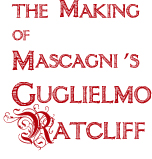 |
<< Previous
5. The Architecture of the Opera
Presented with such a drama as this, Mascagni was forced to give it some kind of overall unity. As has already been pointed out, the work is primarily narrative, with one strong action at the end of Acts One, Two, and Four. Act Three is the exception and crown of the opera. It is in this act that Ratcliff finally comes to terms with himself and the following act is its consequence. As a result, the first, second, and fourth acts are made up of large "blocks" of music, each "block" having its corresponding one in the same position in the other two acts. The "formula" for the construction of these acts may be described in the following manner: Introductory—Narrative—Narrative—Interruption (minor action)—Narrative—Action (major). This may be seen more clearly in the following table:
|
Act One |
Act Two |
Act Four |
| Introductory |
MacGregor's benediction |
Willie recites the Lord's Prayer |
Maria & Margherita
(Same music as in Act One) |
| Narrative |
Douglas' "London Narrative" |
Tom's description of the thieves' way of life |
Maria's Narrative (Same music as in Act One) |
| Narrative |
"Douglas' Journey" |
Ratcliff's invective |
Margherita's Narrative |
Interruption
minor action |
Margherita's ditty
she leaves with Maria |
Lesly enters; he questions Ratcliff |
Arioso (Maria and Ratcliff); she binds his wounds |
| Narrative |
MacGregor's Narrative |
Ratcliff's Narrative |
Ratcliff's "Mirror Speech"
develops into a duet |
Action
major |
Douglas receives Ratcliff's challenge and leaves |
Ratcliff sees the spectres, faints, and leaves to meet Douglas |
The double slaying and Radcliff's suicide |
If these three corresponding acts are designated as "A", with the third act, which possesses its own form (Solo—Solo—Orchestral peroration—Solo), as "B", it then follows that the overall design of the four acts may be expressed as A A B A.
Thus the third act is a "mirror" of the overall form of the opera. That Mascagni meant the "Dream" (the orchestral peroration in Act Three) to be the emotional center of the whole work becomes clear when it is realized that it corresponds to the entire Act Three in the total design. (Click to hear "Ratcliff's Dream".) It should also be noted that the musical form of the Dream is A A B A. Since this third act is primarily devoted to Ratcliff himself, the whole opera can, in a sense, be construed as his own dream, i.e.: Heine's and, by extension, Mascagni's. Surely it is apparent from the Vichi letters that Macagni was drawn to this somber tragedy by its tremendous energy and his belief in the emotions and will of its hero. That Ratcliff is able not only to impose his dreams on the other characters in the drama but determines even to defy both the divine and infernal powers must have seemed to the young composer, with "nothing but chains all around [his] neck" at the Conservatory, as symbol of inherent power of the creative artist. That he was determined to make himself known on the Italian musical scene is evidenced by the fact that he was willing to lay aside his "poor Guglielmo" in an attempt to accomplish his will with another work. That he succeeded with Cavalleria Rusticana is common knowledge; that he never really abandoned Ratcliff, but revised it and presented it as his most important work up to that time, will make this masterpiece even more precious to the true lover of Mascagni.
The above table is beautifully conceived, but I am not convinced that Act Three doesn't follow the pattern in general terms as well. Depending how one interprets what is going on, the third act might be reduced in this manner:
|
Act Three |
| Introductory |
The wind whistles wildly at Ratcliff's entrance. |
| Narrative |
Ratcliff relates his apprehensions for the future. |
| Narrative |
Douglas enters and the two exchange narratives about who they really are. |
Interruption
minor action |
Douglas and Ratcliff fight; Ratcliff loses. |
| Narrative |
Musical narrative: Ratcliff dreams of the specters. |
Action
major |
Because of the dream, Ratcliff is firm in his resolve to take action. |
|